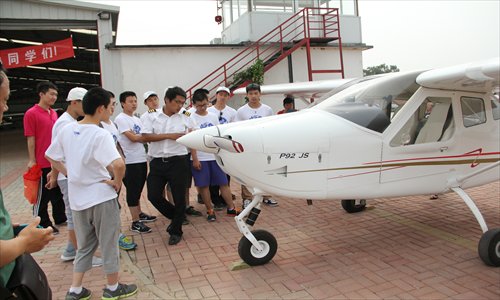Learning their wings

Young pilots-in-training listen attentively to safety instructions. Photo: Courtesy of AOPA
Soaring 300 meters above the earth, Jiang Xinwei felt both nervous and excited as he operated the controls of the Tecnam P92, a small training plane. It was the 17-year-old's first bite of the sweetness of flight. Jiang, a student at Beijing No.57 Middle School, was one of 30 students attending Beijing's first flight experiment class for high school students at Douzhuang Airport in Tianjin. The field course began in July, jointly hosted by the school and the Aircraft Owners and Pilots Association of China (AOPA), who are intent on identifying flight talent as early as possible.
"It's a fantastic experience," Jiang told Metropolitan. "In the past, I've seen the land from the big planes, which fly high above the earth. But the plane I was flying is so close to the land that I clearly could see the farmland, which is neatly laid out. It's a beautiful view."
After studying flight theory for a year, Jiang and his classmates, mostly aged 16 and 17, got their first chance to experience hands-on learning. During this phase of their training, they spend most of their time learning the pre- and post-flight checklists and procedures, as well as how to taxi the plane on the runway.
Ke Yubao, general secretary of AOPA, told Metropolitan, "The pilot experiment classes help to cultivate the talent who will be an important flight force for China. It's necessary to start training them in high school." Chinese national regulations stipulate that the pilot certification can be earned by people as young as 16 years old. Ke added that with the opening up of its low-altitude airspace, China will need more pilots for commercial flights. The Civil Aviation Administration of China (CAAC) forecasts that in the next five to ten years, the number of planes in China will increase annually by 30 percent.
According to Ke, these flight classes can also help students become more well-rounded in their interests, acting as a supplement to the current examination-oriented system that has been accused of stifling creativity.
However, enrolling in the pilot experiment class is not easy. Students first have to pass a physical exam that includes strict standards for eyesight. Only 30 students out of about 300 make the final cut. Based on their physical traits, the students are classified into two groups: the 121 group, who qualify for civil aviation based on factors such as height and superior eyesight, and the 91 group, who are restricted to learning to fly private planes.
Wang Yiding, 16, another flight student, said that the prerequisite flight theory classes of the past year have been more challenging than he expected. Although those twice-weekly classes were free, Jiang said that the basic field course for learning to fly the light-sport aircraft costs 80,000 yuan, and the intermediate courses for small training planes and helicopters cost 150,000 yuan.
Wang told Metropolitan that he will continue the field training over the National Day holiday and winter vacation to obtain the basic pilot certificate for flying private planes, which requires students to log more than 40 hours flight time.
After earning their certification, both Jiang and Wang hope to enroll in an aviation university to continue their training.
"Ten years from now, I want to be flying the best planes," Jiang said proudly.